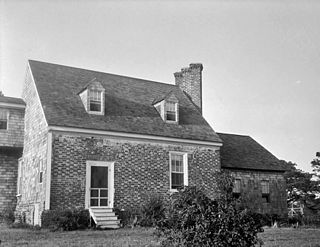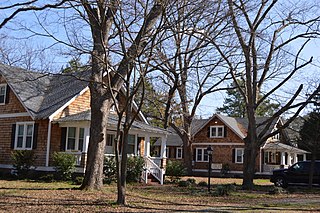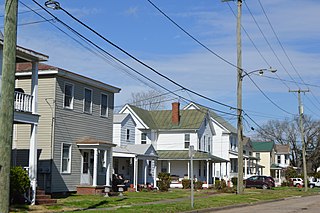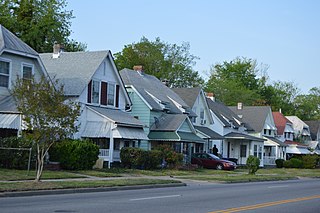
Colonial Place is a residential neighborhood in Norfolk, Virginia. It is a peninsula bordered by 38th Street on the south, and surrounded on three sides by the Lafayette River. It is a relatively racially mixed area that includes mostly single family homes and a few apartment buildings. Many large homes front the water and Mayflower Road arches around the shore of the river.

Park Place is a neighborhood in the western half of Norfolk, Virginia. Its boundaries are roughly Granby Street on the east, Colley Avenue on the west, 23rd Street on the south and up to 38th Street to the north. Within these boundaries Park Place is made up of 4 historic subdivisions; Virginia Place, East Kensington, Park Place, and East Old Dominion Place.

Richlands Historic District is a national historic district located at Richlands, Tazewell County, Virginia. The district encompasses 91 contributing buildings in the central business district of the town of Richlands. It includes residential, commercial, and institutional buildings dating from the late-19th to mid-20th centuries. Notable buildings include the W.B.F. White and Sons Hardware building, Bank of Richlands, Norfolk and Western Railroad Section House, First Christian Church (1908), First United Methodist Church, and Richlands Presbyterian Church. Also located in the district is the separately listed Clinch Valley Coal and Iron Company Office.

Farmville Historic District is a national historic district located at Farmville, Prince Edward County, Virginia. It encompasses 246 contributing buildings and 1 contributing object in the central business district and surrounding residential areas of Farmville. It includes a variety of commercial, residential, institutional, and industrial buildings dating from the mid-19th to early-20th centuries. Notable buildings include the Paulett-Gill house, Farmville Presbyterian Church, Johns Memorial Episcopal Church (1881), Farmville Methodist Church (1907), Hotel Weyanoke (1925), the warehouses of the Dunnington Tobacco Company and Central Virginia Processing, Inc., the former Craddock-Terry Shoe Company, the former Cunningham and Company tobacco prizery, Norfolk and Western Railroad passenger station, Doyne Building, the Watkins M. Abbitt Federal Building (1917), Prince Edward County Courthouse, and the former Farmville High School (1913). Located in the district is the separately listed First Baptist Church.

Winona is a historic home located near Bridgetown, Northampton County, Virginia. It dates to about 1681, and is a small, 1 1/2-story, brick structure with a gable roof. It measures 32 feet, 6 inches, by 27 feet 6 inches. It features an exterior end chimney with three free-standing stacks set diagonally on the base.

Shenandoah Historic District is a national historic district located at Shenandoah, Page County, Virginia. The district includes 451 contributing buildings, 3 contributing sites, and 4 contributing structures in the town of Shenandoah. They include residential, commercial, and institutional buildings in a variety of popular late-19th century and early-20th century architectural styles. Notable buildings include the Eagle Hotel and annex, Western Railway YMCA, Shenandoah General Store, Fields United Methodist Church, Christ United Methodist Church, St. Peter's Lutheran Church, Norfolk and Western Railway Station, and Shenandoah High School. Located in the district is the separately listed Shenandoah Land and Improvement Company Office.

Dublin Historic District is a national historic district located at Dublin, Pulaski County, Virginia. It encompasses 97 contributing buildings in the town of Dublin. It includes a variety of residential, commercial, and institutional buildings dated as early as the mid-19th century. Notable buildings include the Sutton House, Norfolk and Western Railroad Depot (1913), Bower Funeral Service, Baskerville-St.Clair House, Darst Building (1871), Bank of Pulaski County, McCorkle House (1878), Dublin Presbyterian Church, Dublin Methodist Church (1875), Grace Baptist Church, and the Municipal Building.

Marion Historic District is a national historic district located at Marion, Smyth County, Virginia. The district includes 361 contributing buildings, 2 contributing sites, and 1 contributing object in the central business district and surrounding residential areas of Marion. It includes a variety of residential, commercial, institutional, industrial, and governmental buildings primarily dating from the mid-19th to mid-20th centuries. Notable buildings include the Sheffey Loom House, Odd Fellows Lodge, Look & Lincoln Wagon Factory warehouse, the Beaux-Arts style Marion County Courthouse (1905), Mt. Pleasant Methodist Church, Courtview Building (1890s), Marion High School (1907-1908), Marion Junior College (1912), the Overall Factory, Weiler Building, Bank of Marion (1922), Royal Oak Presbyterian Church (1923), Marion Municipal Building (1935), Marion Post Office (1936), and a Lustron house (1948). Also located in the district are the separately listed Hotel Lincoln, Lincoln Theatre, Marion Male Academy, and Norfolk & Western Railway Depot.

Oaklette Historic District is a national historic district located at Chesapeake, Virginia. The district encompasses 30 contributing buildings and 1 contributing object in an early-20th century planned streetcar suburb of Norfolk, Virginia. It is a primarily residential district that developed starting about World War I. The dwellings include representative examples of the Colonial Revival and Bungalow styles. Notable buildings include the Savage House (1915-1919), Pascal Paxson House (1901), George Wesley Jones House (1925), Samuel Paxson House (1906), Colonna Estate Caretaker's House (1925), and the Baker House (1910).

South Norfolk Historic District is a national historic district located at Chesapeake, Virginia. The district encompasses 668 contributing buildings and 1 contributing site in what started as a planned community of Norfolk County, Virginia and grew to become an independent city. South Norfolk was never part of Norfolk, Virginia. In fact, the two cities are separated by the Eastern Branch of the Elizabeth River. South Norfolk is a primarily residential district that was developed between 1890 and 1930. The dwellings include representative examples of the Colonial Revival, Stick Style, and Queen Anne styles. The district also includes several churches, a school, a park, and a small local business district.

The Riverview Historic District is a national historic district located at Norfolk, Virginia. It encompasses 200 contributing buildings in a primarily residential section of Norfolk. It developed primarily during the first quarter of the 20th century, as a suburban community north of the growing downtown area of Norfolk. The neighborhood includes notable examples of a variety of Late Victorian and Late 19th And 20th Century Revival styles.

The North Ghent Historic District is a national historic district located at Norfolk, Virginia. It encompasses 322 contributing buildings in a primarily residential section of Norfolk. It developed primarily between 1897 and 1912 as a northward extension of Ghent. The neighborhood includes notable examples of a variety of architectural styles including the Greek Revival and Queen Anne styles. Notable non-residential buildings include the First Presbyterian Church, Ohef Sholom Temple, and Ghent Methodist Church (1921). Located in the district is the separately listed Christ and St. Luke's Church.

The West Freemason Street Area Historic District is a national historic district located at Norfolk, Virginia. It encompasses 48 contributing buildings in a primarily residential section on the western edge of the center city of Norfolk. It developed between the late-18th and early-20th centuries and includes notable examples of the Federal, Greek Revival, and Late Victorian styles. Notable buildings include Kenmure House Glisson House, Whittle House, McCullough Row, and the Camp-Hubard house. Located in the district is the separately listed Allmand-Archer House.

The Lafayette Residence Park is a national historic district located at Norfolk, Virginia. It encompasses 284 contributing buildings in a primarily residential section and suburban community north of the downtown area of Norfolk. It developed during the first quarter of the 20th century and includes notable examples of the Gothic Revival and Queen Anne styles. Notable non-residential buildings include the Lafayette Grammar School (1908-1910), Church of the Epiphany (1920), and the First United Methodist Church (1922).

The Ballentine Place Historic District is a national historic district located at Norfolk, Virginia. It encompasses 860 contributing buildings, 1 contributing site, and 1 contributing object in a cohesive residential neighborhood located near the center of Norfolk. It was platted in 1909, and largely developed between 1915 and 1953. The district includes a park developed in the 1930s by the Works Progress Administration (WPA). Notable non-residential buildings include the Ballentine School (1915-1916), Trinity Baptist Church (1953), United New Life Church of Christ in Holiness Church (1930), the Emmanuel Holy Temple Church, and the Tabernacle of the Congregation Church of God in Christ (1930).

The Chesterfield Heights Historic District is a national historic district located at Norfolk, Virginia. It encompasses 402 contributing buildings, 1 contributing site, and 1 contributing structure in a cohesive residential neighborhood located just to the northeast of downtown Norfolk. It was platted in 1904, and largely developed between 1915 and 1950. There are notable examples of Queen Anne and Italianate style residential architecture. Notable non-residential buildings include the St. Luke's Holiness Church of Christ's Disciples, Monticello Baptist Church (1925), and the Garrett Community Church (1940).

Cradock Historic District is a national historic district located at Portsmouth, Virginia. It encompasses 759 contributing buildings and 1 contributing structure in a primarily residential section of Portsmouth. It was developed starting in 1918, as a planned community of Colonial Revival and Bungalow style single family residences. It was developed by the United States Housing Corporation as a result of the rapid influx of workers at the Norfolk Naval Shipyard during World War I.

Truxtun Historic District is a national historic district located at Portsmouth, Virginia. It encompasses 241 contributing buildings in a primarily residential section of Portsmouth. It was developed between 1918 and 1920 as a planned community of Colonial Revival style single family residences. It was developed by the United States Housing Corporation as a result of the rapid influx of workers at the Norfolk Naval Shipyard during World War I. It was the first wartime government housing project constructed exclusively for African-American residents.

Port Norfolk Historic District is a national historic district located at Portsmouth, Virginia. It encompasses 621 contributing buildings and 1 contributing site in a primarily residential section of suburban Portsmouth. It was developed between about 1890 and 1910, and includes notable examples of Queen Anne, Bungalow / American Craftsman, and American Foursquare style single family residences.

Norfolk and Western Railway Freight Station is a historic freight depot located in the Melrose-Rugby neighborhood of Roanoke, Virginia. It encompasses 111 contributing buildings and 2 contributing objects in a planned residential subdivision, with most of the dwellings being built between the late 1910s and late 1940s. It is a primarily residential district with single-family dwellings. The houses include American Craftsman-style bungalow, American Foursquare, and Cape Cod style. The building houses the Virginia Museum of Transportation























